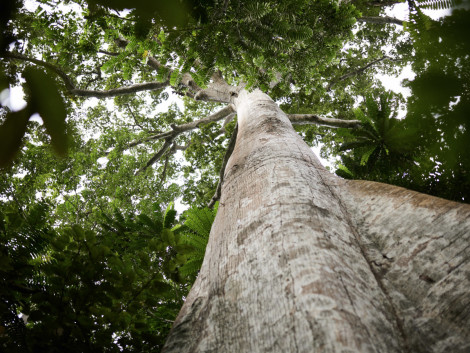

News | 27.02.2023
As part of the organization of the One Forest Summit, ATIBT participates in the work on the theme "Innovative Finance", the opportunity to recall the role of certified foresters as an actor of conservation and the need to develop innovative financing mechanisms.

February 24, 2023 - As part of the organization of the One Forest Summit, to be held in Libreville on March 1 and 2, ATIBT is associated with the working group in charge of the "Innovative Finance" theme. New commitments and concrete initiatives are expected on the development of innovative sources of financing, particularly by exploring market-based solutions for biodiversity conservation.
This is an opportunity to recall the position shared by ATIBT on this subject.
Certified forest managers as conservation actors
ATIBT represents the certified tropical forestry sector, and counts among its members forest managers in the Congo Basin and the Amazon. We support the fight against deforestation, the preservation and restoration of tropical forests which are essential to reduce CO2 emissions and strengthen the resilience of ecosystems and natural carbon sinks. Preserving tropical forests is also essential for conserving biodiversity, preserving water resources, improving food security and maintaining livelihoods for local people. The role of ecosystems cannot be summarized as simply sequestering carbon.
Our members have implemented effective measures for sustainable environmental and social forest management through recognized certification systems such as PEFC (PAFC in the Congo Basin) and FSC. Through this approach, we would like to recall the role of certified forest managers as actors of conservation. Through measures such as the conservation of High Conservation Value Forests, monitoring of their concessions, anti-poaching and hunting management, application of a management plan based on exhaustive inventories, monitoring of greenhouse gases, activities and public-private partnerships or with organizations recognized in conservation, these forest managers maintain biodiversity (this is now proven by numerous studies[1]). This model is innovative because it is both economically profitable and environmentally beneficial. It is then the forestry companies themselves that contribute to conservation. This model should therefore be recognized as part of the solution, alongside "classic" conservation measures such as protected areas and national parks.
However, these approaches are not valued to their full extent, and we observe that the sustainable forestry and wood sector does not have access to carbon finance as it is conceived by the mechanisms of "certification of the voluntary carbon market". Indeed, there are currently few sustainable forest management projects registered with carbon certification standards. One of the first constraints to the development of these projects is the demonstration of additionality, i.e., the idea that the "project" (in this case, improved management practices) would not have been possible without carbon finance. While this is possible, concessions that are already certified as sustainable would have a harder time demonstrating additionality than concessions that are not subject to conservation measures and are at high risk of deforestation, which are more likely to meet the additionality criteria. This raises a first question: do carbon certification mechanisms allow for the preservation of tropical forests?[2]
In addition, the credibility of carbon credits from forestry projects, and carbon offsetting in general, has been called into question by recent criticism[3]. Moreover, the issue of carbon credits is part of an "offsetting" logic (a buyer uses the credits to offset his own emissions). However, voices are now being raised to move away from this logic and speak instead of "contribution" to the global effort to fight climate change, which involves not only a global reduction in emissions but also the protection of biodiversity. This logic of contributions rather than offsets was also favored at COP27. We would then speak of a "carbon contribution" or "biodiversity contribution", financed, for example, in the form of certificates that do not give the right to offset.
In this respect, we agree with the analysis of Alain Karsenty, a researcher at CIRAD and an active member of ATIBT, who believes that the logic of compensation should give way to a logic of contribution (to collective efforts to preserve the planet)[4]. He proposes that we abandon the term "carbon credits" in favor of what could be "positive impact certificates" covering carbon, biodiversity and social issues (what benefits for local communities?).
ATIBT is also involved in the OBC initiative (Organization for Biodiversity Certificate)[5], which aims to create an operational tool for assessing local positive impacts on biodiversity or on the carrying capacity of biodiversity, based on a proposed methodology built on technical and scientific consensus.
It is therefore imperative to implement alternative financing strategies and conservation interventions to safeguard carbon stocks and biodiversity in these vulnerable forests.
ATIBT believes in the development of the concept of "biodiversity, climate and social impact certificates" (a more appropriate formulation than "carbon credits" or "biodiversity credits"), which could be used by companies to complement (not replace) their efforts to reduce their own carbon or biodiversity footprint.
Carbon finance, still an opportunity for certified concessions?
Although the subject is less recent and already widely debated, the issue of carbon finance is nevertheless part of the reflections that ATIBT is conducting through its Carbon and Biodiversity Commission. Discussions have focused on "REDD+" avoided deforestation projects, i.e., conservation projects aimed at avoiding a (mostly unplanned) threat of deforestation or forest degradation. Forest concessionaires, especially those with existing sustainable management practices, do not fit into this type of project.
However, there are other opportunities for forest concessionaires to benefit from carbon finance via "IFM" (Improved Forest Management) projects. This type of project concerns, for example, the implementation of "RIL-C" (Reduced Impact Logging for Climate Change mitigation) practices, the increase of rotation durations and DMAs, the conversion of low-productivity forests to high-productivity forests, the conservation of certain areas within the concession, etc. Too few IFM projects exist to date, methodologies are complex and there are technical barriers (e.g., demonstrating that without carbon finance, improved practices would not have occurred) that are holding back forest concessionaires. The Carbon and Biodiversity Commission is studying how to remove these obstacles and how to connect investors with project leaders on the ground.
[1] Ellis et al 2019 "Reduced-impact logging for climate change mitigation (RIL-C) can halve selective logging emissions from tropical forests"
Polisar, J. et al 2027. Using certified timber extraction to benefit jaguar and ecosystem conservation. Ambio 46, 588–603
16. Sollmann, R. et al 2017. Quantifying mammal biodiversity co-benefits in certified tropical forests. Divers. Distrib. 23, 317–328
[2] Read a scientific study published in Nature (Koh, L.P. et al., 2021)
[3] Read the Guardian article and Verra's response. Criticism is currently directed at "avoided deforestation" projects, whose baseline is difficult to measure and is controversial. But this undermines the overall credibility of the forest carbon credit certification mechanism.
[4] Lire à ce sujet la publication suivante : Financement international de la biodiversité : remettre les paiements pour services écosystémiques dans le cadre d’une approche de co-investissement pour le développement durable
[5] L'OBC a été co-fondée par aDryada et Le Printemps des Terres, en collaboration avec Carbone 4 et le Muséum National d'Histoire Naturelle français. L’intention est également de permettre l'émergence de projets mixtes carbone-biodiversité afin de favoriser les initiatives qui encouragent la restauration avec diverses espèces indigènes et, au final, de discriminer les crédits carbone ayant une valeur faible ou négative pour la biodiversité.